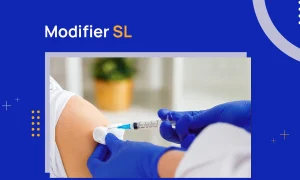If you have worked in rehab, you might have come across CPT code 97110. Rehab specialists and physical therapists use it frequently in their daily billing. However, we have seen countless clinics struggle with denials simply because they misunderstood this simple code and its proper usage.
Talk to any biller in a physical therapy (PT) clinic, and they will tell you how 97110 has been a constant headache. That’s why our billing experts at NeuraBill have compiled this guide on CPT code 97110. So, let’s start.
CPT Code 97110 Description
CPT code 97110 is defined as: “Therapeutic exercises that are undertaken to develop strength, endurance, range of motion, and flexibility, with one-on-one patient contact by the provider, every 15 minutes.” The code 97110 falls under the Physical Medicine and Rehabilitation Therapeutic Procedures section of the CPT manual.
Sounds confusing? Let’s break it down in simple words. The CPT code 97110 is used for the billing of structured and planned therapeutic exercises performed under the direct supervision of a PT specialist. These exercises must specifically address identified impairments by targeting strength, endurance, flexibility, and range of motion. The exercises must be reasonable, necessary, and involve skilled intervention and expertise of a qualified healthcare professional.
Key elements of CPT code 97110 include:
- Direct one-on-one patient contact with a qualified provider
- 15-minute time increments (subject to the 8-minute rule)
- Focus on improving physical capabilities in specific areas
An important thing that many billers miss is that the therapeutic exercises provided under 97110 must be different from other rehabilitation codes, such as neuromuscular reeducation or other therapeutic activities like CPT 97530. However, if the patient’s condition requires a more comprehensive treatment, these exercises can be used in conjunction. The differences between these codes are minor, but if you mix them up, your claims will be denied.
Appropriate Use Cases for CPT Code 97110
To better understand the applications of CPT code 97110, let’s look at some real-world scenarios in which it can be used:
Post-Surgical Rehabilitation
The use of CPT code 97110 is very common among orthopedic patients. After orthopedic surgeries like ACL reconstruction, replacement of joints, or rotator cuff repairs, patients often require specific routine exercises to regain strength and become accustomed to new replacements.
After surgery, 97110 may be used for:
- Progressive resistance training targeting the muscle groups weakened after surgery
- Range of motion exercises to prevent contractures
- Targeted strengthening exercises for surgical sites
Musculoskeletal Injuries
Another common scenario where CPT code 97110 is frequently used is treating musculoskeletal injuries. Patients with sprains, strains, and other soft tissue injuries respond well to therapeutic exercise programs. For instance, you can use 97110 in the treatment of the following musculoskeletal injuries:
- Graded strengthening exercises for sprained ankles
- Controlled movement patterns for back injuries
- Progressive loading exercises for tendon injuries
Modifiers to Append with CPT Code 97110
The most frequently used modifiers with CPT code 97110 are:
| Modifier | Description | Usage Guidelines |
|---|---|---|
| GP | Used when services are provided under an outpatient physical therapy treatment plan | Required by Medicare and many insurance carriers for physical therapy services |
| GO | Services delivered under an outpatient occupational therapy plan of care | Used when occupational therapists perform therapeutic exercises |
| 59 | Distinct procedural service | This code is used to indicate that a procedure is distinct from other services performed on the same day |
| CQ | Outpatient physical therapy services furnished in whole or in part by a physical therapist assistant (PTA) | Required for Medicare when PTAs provide services (affects reimbursement rate) |
| CO | Outpatient occupational therapy services delivered fully or partially by an occupational therapy assistant (OTA) | Required for Medicare when services are provided by OTAs (affects reimbursement rate) |
| KX | Requirements specified in the medical policy have been met | Used to indicate that therapy services exceed the therapy cap but are medically necessary |
CPT 97110 requires the 59 modifier when billed with certain codes, including 36591, 36592, and 96523. So, always check the latest NCCI edits and the insurance payer requirements before filing the claim.
Additionally, incorrect usage of modifiers is practically sending an invitation to auditors. So, always back up your case with proper documentation.
Reimbursement Guidelines for CPT Code 97110
Adhering to the following billing and reimbursement guidelines specific to code 97110 will help you avoid claim denials.
The 8-Minute Rule
CPT code 97110 is a time-based code billed in 15-minute units. Medicare and many private insurance companies follow the 8-minute rule for billing time-based services. Under this rule, at least 8 minutes of direct one-on-one therapy must be provided to bill for one unit. For multiple units, follow this pattern:
| Service Time | No. of Units |
|---|---|
| 0-7 minutes | 0 unit |
| 8-22 minutes | 1 unit |
| 23-37 minutes | 2 units |
| 38-52 minutes | 3 units |
| 53-67 minutes | 4 units |
| 68-82 minutes | 5 units |
Please note that the time spent on documentation or other administrative tasks cannot be included in the billing cycle.
Documentation Requirements
Comprehensive documentation is the key to successful CPT code 97110 billing. Relevant documents and patient records are necessary for justifying medical necessity and ensuring reimbursement. As per the Medicare guidelines, the following documentation and medical records must be appended with 97110 claims:
General Requirements:
- Beneficiary’s name and date of service (DOS).
- ADR letter and claim cover sheet.
- Appropriate signatures with credentials of the person performing/supervising the service.
- Amendments/corrections/delayed entries are initialed, dated, and made within 30 days of DOS.
Initial Evaluation:
- Diagnosis and relevant medical history
- Current functional limitations
- Objective measurements (ROM, strength, etc.)
- Specific, measurable goals
- Plan of care, including frequency and duration
Daily Treatment Notes:
- Specific exercises performed
- Parameters (sets, repetitions, resistance)
- Total time spent on each exercise
- Patient’s response to treatment
- Progress toward functional goals
Progress Notes (at least every 10 visits):
- Updated objective measurements
- Comparison to baseline and previous measurements
- Progress toward functional goals
- Modifications to the plan of care
- Justification for continued treatment
Final Thoughts on CPT Code 97110
There you have it – the complete guide on CPT code 97110. 97110 is one of the most used physical therapy codes, and getting it right means better revenue cycle management and less worry about potential audits. By following the guidelines provided in this blog, you can successfully file a claim with 97110.
However, healthcare regulations and reimbursement models change continuously, and it can be difficult to cope with them. That’s where we can help. Our dedicated team of medical billers and coders has decades of experience in providing physical therapy billing services. We can help you supercharge your collections.



